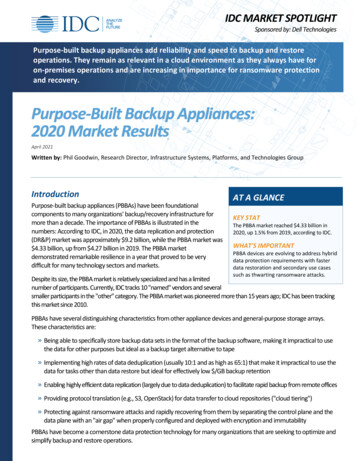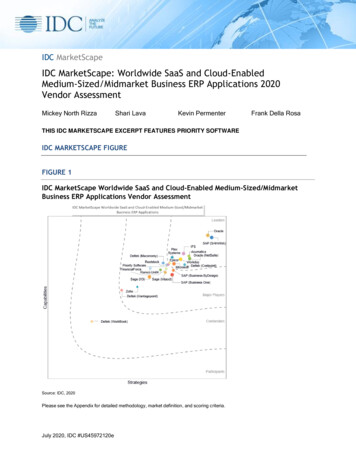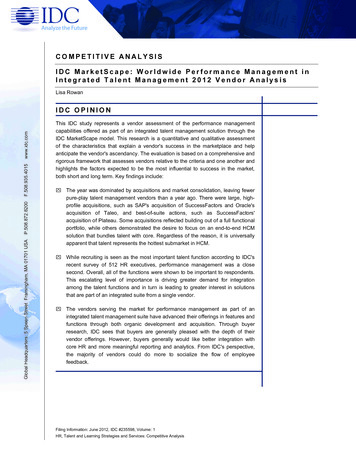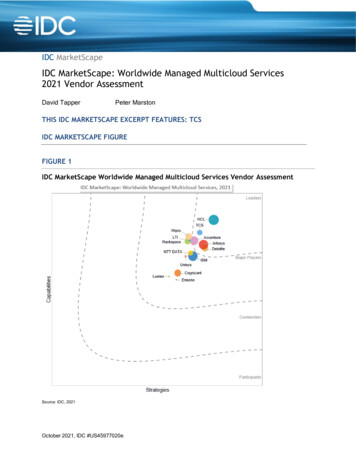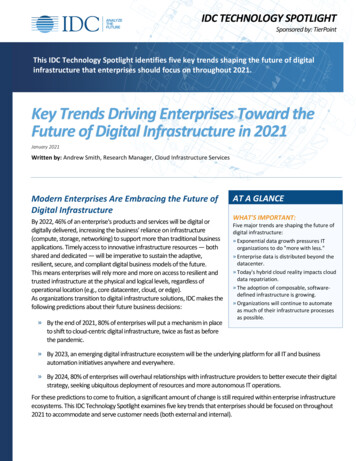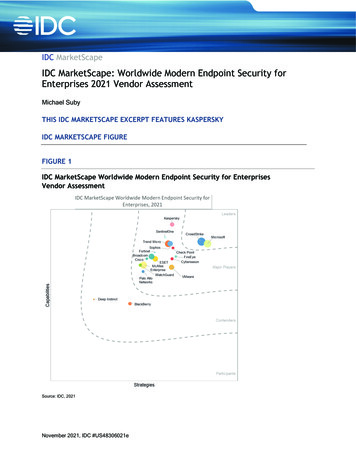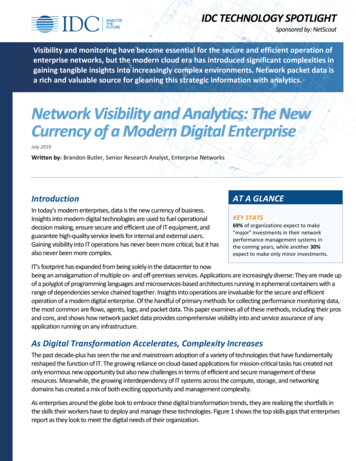
Transcription
IDC TECHNOLOGY SPOTLIGHTSponsored by: NetScoutVisibility and monitoring have become essential for the secure and efficient operation ofenterprise networks, but the modern cloud era has introduced significant complexities ingaining tangible insights into increasingly complex environments. Network packet data isa rich and valuable source for gleaning this strategic information with analytics.Network Visibility and Analytics: The NewCurrency of a Modern Digital EnterpriseJuly 2019Written by: Brandon Butler, Senior Research Analyst, Enterprise NetworksIntroductionIn today's modern enterprises, data is the new currency of business.Insights into modern digital technologies are used to fuel operationaldecision making, ensure secure and efficient use of IT equipment, andguarantee high-quality service levels for internal and external users.Gaining visibility into IT operations has never been more critical, but it hasalso never been more complex.AT A GLANCEKEY STATS69% of organizations expect to make"major" investments in their networkperformance management systems inthe coming years, while another 30%expect to make only minor investments.IT's footprint has expanded from being solely in the datacenter to nowbeing an amalgamation of multiple on- and off-premises services. Applications are increasingly diverse: They are made upof a polyglot of programming languages and microservices-based architectures running in ephemeral containers with arange of dependencies service chained together. Insights into operations are invaluable for the secure and efficientoperation of a modern digital enterprise. Of the handful of primary methods for collecting performance monitoring data,the most common are flows, agents, logs, and packet data. This paper examines all of these methods, including their prosand cons, and shows how network packet data provides comprehensive visibility into and service assurance of anyapplication running on any infrastructure.As Digital Transformation Accelerates, Complexity IncreasesThe past decade-plus has seen the rise and mainstream adoption of a variety of technologies that have fundamentallyreshaped the function of IT. The growing reliance on cloud-based applications for mission-critical tasks has created notonly enormous new opportunity but also new challenges in terms of efficient and secure management of theseresources. Meanwhile, the growing interdependency of IT systems across the compute, storage, and networkingdomains has created a mix of both exciting opportunity and management complexity.As enterprises around the globe look to embrace these digital transformation trends, they are realizing the shortfalls inthe skills their workers have to deploy and manage these technologies. Figure 1 shows the top skills gaps that enterprisesreport as they look to meet the digital needs of their organization.
IDC TECHNOLOGY SPOTLIGHTNetwork Visibility and Analytics: The New Currency of a Modern Digital EnterpriseFIGURE 1: Skills Gaps in IT OrganizationsQ How would you describe your organization's skills gaps in the following areas of digitalexpertise over the next five years to meet your organization's business goals?Cloud infrastructure and apps30%Customer experience tech29%3D printing29%AL/ML/DL29%Robotics29%Governance tools28%Data integration28%IoT27%Data mining/analytics27%Wearables27%Agile development processes26%Security protection25%Mobile technology25%Social media–enabled business %30%Serious gaps40%35%50%Some gaps60%70%80%90%100%No gapsn 400Source: IDC's Cloud and Artificial Intelligence Perceptions Survey, January 2018This skills gap is a critical issue in monitoring and analytics. Organizations need to comprehensively monitor and analyze allaspects of the network — on-premises and cloud as well as both traditional and newly developed applications — but thishas become an enormous challenge given the variety of technologies relied on today and the many different ways they arearchitected. It's a significant advantage if enterprises can use existing tools they are comfortable with and have invested in asopposed to managing multiple niche solutions. Having a monitoring and analytics platform that is flexible and extensible andworks across a variety of environments is increasingly becoming a critical decision factor for enterprises.IT Monitoring and Performance Collection MethodsThe need for monitoring and performance analytics has crystallized in recent years. A recent IDC survey of enterprisenetwork performance managers found that 68.8% of U.S. organizations expect to make major investments in networkperformance management (NPM) technology in the coming year, while 30.4% expect to make minor investments;less than 1% have no plans to change their spending. This healthy level of investment has given rise to a wide variety ofmethods for collecting and analyzing performance data. The following sections discuss the top methods used inenterprises today.US45375719Page 2
IDC TECHNOLOGY SPOTLIGHTNetwork Visibility and Analytics: The New Currency of a Modern Digital EnterpriseFlowsFlow-based monitoring tools derive data from network infrastructure, which can be programmed to automatically recordand export system operations. These flows require a network operator to configure a destination — a collection platformknown as a flow manager, which must be set up and managed to expose these network flows to operators. Netflow, whichis generated from Cisco networking equipment, is a common example of a flow technology.Flow data is volumetric, which means it does a good job of describing the "who," "what,"and "when" of network activity. However, flow data lacks the granularity needed formeaningful insights into user experience and troubleshooting. Flows can create a bandwidthstrain for the infrastructure equipment that generates flow data, taxing the equipment anddraining the infrastructure of the resources that it needs to perform its core task. Anotherchallenge with flows is that as the size of the environment scales up, the amount of flowdata scales linearly, creating an increasingly difficult management problem. Flows aretherefore commonly deployed in small or medium-sized enterprises or in organizations thatdo not have a need or a budget for deep granular insights into IT operations.Flows, agents, logs,and packet dataeach have uniquecharacteristicsfor collectingand analyzingperformance datain the moderndigital enterprise.AgentsAgent-based monitoring platforms are most typically used in application development andtesting to provide detailed visibility into code performance of specific operating system (OS)or application development environments. Agents are typically focused on specificprogramming languages, making them difficult to use in polyglot environments, and they do not inherently provideperformance metrics of the infrastructure layer. This means they are typically used for application-specific monitoring,particularly in development and quality assurance.LogsLogs are the written diagnostics records produced by various infrastructure and applications. Infrastructure logs aretypically specific to the OS and the vendor, but there is no single log standard. For example, Windows and Linux haveseparate log formats. Syslog, commonly mistaken for a standard, is for log transport, but not log content. As a result, logsare typically "noisy," meaning they are voluminous in size with low-fidelity data that requires extensive supportingarchitectures for storing, indexing, and analyzing them. Logs are commonly used in security information and eventmanagement (SIEM) scenarios.Packet DataPacket data derives from monitoring the connections between digital points. These packets can be analyzed in real timeto provide insights into any communication across the network, including the performance of components at both theapplication layer and the infrastructure layer; packet data is also able to capture end-user experience metrics.The entirety of the packet, including layers of embedded protocols and payloads, is processed and transformed intoreal-time metadata insights, which makes for a highly scalable architecture. At the same time, some commercial packetdata solutions also store the packets for after-the-fact forensic investigations. While storing packets is not necessary,having the ability to quickly go from metadata to packet forensics creates significant automation that can be leveragedby operations and security teams. Because all network traffic uses packets to transit data, the method can be deployedon-premises or in the cloud, and no interaction can escape it.US45375719Page 3
IDC TECHNOLOGY SPOTLIGHTNetwork Visibility and Analytics: The New Currency of a Modern Digital EnterpriseAnalysis Engines Are Only as Good as the Data They Have to Work WithChoosing the right monitoring method is a critical decision for enterprises. Given how each method has its own strengths,it's important that enterprises choose a collection method that fits their use cases. Typically, data collected by themonitoring system feeds an analysis engine that surfaces meaningful insights to the network or IT operators. Theseanalysis engines are only as good as the data they have to work with though. If a low-fidelity data source is used that doesnot provide a comprehensive view into the entire IT operation (both on- and off-premises), then the engine will not beable to provide relevant analysis. Furthermore, if a "noisy" type of data collection method is used, then it's more difficultfor the analysis engine to find germane insights.Enterprises are looking for performance management platforms that meet the needs of their business, as evidenced bythe top investment priorities for performance management systems shown in Figure 2. A key priority is for the system tobe able to monitor both on- and off-premises resources, including SaaS and IaaS. Data should be available across a rangeof metrics, from application to infrastructure and user experience. Packet data is in a unique position to be able to satisfyall of these requirements because it is network based, meaning it sees every transaction in the enterprise. Other forms ofperformance monitoring may be able to only partially cover each of these points.FIGURE 2: Top Priorities as Organizations Invest in Network Visibility and AnalyticsCloud services monitoring60.0Application performance monitoring47.6Real-time application monitoring47.2SaaS monitoring45.2Real-time network monitoring43.6Integration with networking software (SDN)41.201020304050(% of respondents)6070n 250Source: IDC's NPM Survey of Network Managers, 2017US45375719Page 4
IDC TECHNOLOGY SPOTLIGHTNetwork Visibility and Analytics: The New Currency of a Modern Digital EnterpriseThe Value of Performance AnalyticsGaining visibility and insights into the performance of the IT environment has never been more critical. Enterprises acrossthe globe have a strong desire for a powerful, pervasive, and detailed performance management platform that canprovide relevant insights into all aspects of the ever-expanding enterprise IT footprint. The performance insights andanalysis are used in a variety of ways:» To monitor, improve, and ensure the performance and user experience of infrastructure and applications» To provide detailed analysis of ongoing operations, including the types of applications and services on the network,identification of bottlenecks, historical trend analysis, and future performance prediction» To optimize the environment, including to automate the provisioning and management of additional capacitywhere and when needed» To recognize anomalous activity and flag it to identify potential security issues or performance degradationsConsidering NetScout's Adaptive Service IntelligenceNetScout's Adaptive Service Intelligence (ASI) platform uses packet data to capture and produce relevant, real-time,granular details about the operations of the enterprise applications, infrastructure, and network. Because the systemsources its insights from passive monitoring of IP communications, it can be deployed anywhere — on-premises or in thecloud, in physical or virtual environments — meaning it can see everything happening across the entire enterprise. Itanalyzes the metadata of packets traversing any two points in the network while efficientlystoring the packets as a forensic investigative tool. Combined with analytics capabilities, ASIflags the important events it captures, including known and learned security incidents asVisibility into what iswell as performance degradations experienced by equipment or end users. Because it seeshappening in theall communications, it can map service- and application-specific infrastructure in real time.network is aKey abilities of NetScout ASI include the following:» Produces actionable insights based on end-to-end, pervasive visibility» Provides insight and analysis on a range of management domains, includinginfrastructure, application, and end-user experience» Analyzes data in real time to provide insights into the performance of the network andbroader IT environmentfoundationalcomponent ofautomating andsecuring the ITenvironment.» Extends from on-premises to the cloud as well as virtual or physical environments» Is not tied to a single programming language or flow standardThe extensible nature of ASI is a key point: As enterprises look to digitally expand their organizations, opportunity abounds,but so does management complexity. Any new cloud service that is spun up, any new application that is onboarded, or anynew user on the network should not require a reconfiguration and rollout of new performance and security monitoring andanalytics tools. The ability for packet data to provide actionable insights across any range of environments and applicationtypes means it is extensible as the use cases and needs of the business evolve into the future.US45375719Page 5
IDC TECHNOLOGY SPOTLIGHTNetwork Visibility and Analytics: The New Currency of a Modern Digital EnterpriseChallengesNetScout has built the next-generation IT performance monitoring method using packet-based data and a powerfulanalytics engine in ASI. A key challenge for NetScout will be to prove to customers the value-added differentiation ofpacket-based data versus other data collection forms. Enterprises may have relied on other types of monitoringplatforms in the past, but the complexity of the modern IT environment will force organizations to consider more holisticsolutions.ConclusionOrganizations are looking for ways to get pervasive visibility into what's happening in their IT environments, even as theenterprise footprint expands from the traditional on-premises physical world to an increasingly diverse cloud-basedenvironment. Enterprises should consider a visibility and analytics platform that is able to provide real-time actionableinsights into the broad array of technologies that make up today's modern digital business.About the AnalystBrandon Butler, Senior Research Analyst, Enterprise NetworksBrandon Butler is a Senior Research Analyst with IDC's Network Infrastructure group covering EnterpriseNetworks. He is responsible for market and technology trends, forecasts, and competitive analysis inEthernet switching, routing, wireless LAN, as well as network management software. He also assists inend-user surveys, interviews, and advisory services and is a frequent speaker at industry events.US45375719Page 6
IDC TECHNOLOGY SPOTLIGHTNetwork Visibility and Analytics: The New Currency of a Modern Digital EnterpriseMESSAGE FROM THE SPONSORIt is widely accepted that visibility into the performance of IT is critical to success of digital enterprise. Yet with everywave of technology adoption existing domain- and silo-based management approaches bring us an ever morecomplex tool glut, which are hard to use, hard to manage, and have high costs. Broad adoption of Hybrid Multi-Cloud(HMC) architectures provides an opportunity to reexamine and streamline fractured monitoring strategies and theirassociated high administrative resource requirements at a time of historic skilled staff shortage. The universality ofpacket data makes it the ideal tool for pervasive visibility into the health and performance of all applications andinfrastructure regardless of location, while rapid access to packet forensics automates otherwise cumbersomeworkflows by operations and security teams for troubleshooting and incident response respectively.The content in this paper was adapted from existing IDC research published on www.idc.com.IDC Corporate USA5 Speen StreetFramingham, MA 01701, USAT 508.872.8200This publication was produced by IDC Custom Solutions. The opinion, analysis, and research results presented herein are drawn frommore detailed research and analysis independently conducted and published by IDC, unless specific vendor sponsorship is noted. IDCCustom Solutions makes IDC content available in a wide range of formats for distribution by various companies. A license to distributeIDC content does not imply endorsement of or opinion about the licensee.Twitter @IDCExternal Publication of IDC Information and Data — Any IDC information that is to be used in advertising, press releases, or promotionalmaterials requires prior written approval from the appropriate IDC Vice President or Country Manager. A draft of the proposeddocument should accompany any such request. IDC reserves the right to deny approval of external usage for any reason.idc-insights-community.comCopyright 2019 IDC. Reproduction without written permission is completely forbidden.F 508.935.4015www.idc.comUS45375719Page 7
The need for monitoring and performance analytics has crystallized in recent years. A recent IDC survey of enterprise network performance managers found that 68.8% of U.S. organizations expect to make major investments in network performance management (NPM) technology in the coming year, while 30.4% expect to make minor investments;
